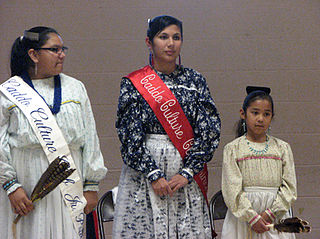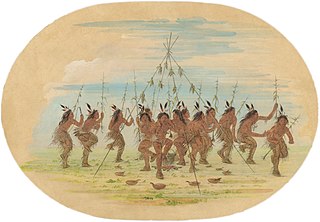This article contains content that is written like an advertisement .(July 2023) |
The Choctaw Indian Fair is an annual festival celebrating traditional Choctaw heritage.
This article contains content that is written like an advertisement .(July 2023) |
The Choctaw Indian Fair is an annual festival celebrating traditional Choctaw heritage.
For centuries the Mississippi Choctaws have gathered at the ripening of the first corn. This gathering was called "The New Corn Ceremony" or "Green Corn Festival." The present day "Choctaw Indian Fair" has roots in this ancient celebration.
The Fair has long been a time for Choctaws to gather and pay homage to their traditions and heritage but it has also emerged as an opportunity for the Tribe to welcome visitors to the reservation and share their way of life.
Even though the Fair has been around for many years, the Mississippi Choctaw say that the fair began to evolve into the Annual Fair it has become in 1949. The Choctaw Princess Pageant was not added to the fair until 1955 when Patsy Sam (Buffington) was crowned as the first Choctaw Princess.
Nashville-style country music became part of the Choctaw Indian Fair in the 1960s when Nashville stars such as Chet Atkins, Connie Smith, Lester Flatt, Mac Wiseman, Jerry Reed, Johnny Gimble, Pig Robbins, and Merle Travis noticed what the Choctaws were doing with their Annual Fair. Each of these performers performed for free at the fair as a tribute to the Choctaw Nation and in support of the fair. In the 1970s, paid performers were added to the Fair and now the last three nights of the Fair include paid country music performers.
Another important element of the annual fair has been a reemergence of the traditional dances of the Choctaw. In the 1970s, an effort began to revive many of the traditional dances of the Choctaw that were no longer being danced. Because of the renewed interest in traditional dance brought about by the Annual Fair, each morning and afternoon dance groups from different communities perform for fairgoers. Many of the dance groups now make paid appearances outside the reservation. The Choctaw dance performed at the Annual Fair is seen as an authentic expression of the ancient Choctaw traditional culture and gives people who attend the fair a glimpse into that culture.
Along with music and dance, many Choctaw artists display their bead work, baskets, drums, and other art during the Fair. At many of the artists' tables, fairgoers will see the skills of the artist being passed down traditionally as there will be two or three generations of the same family working on projects.
The 2021 Choctaw Indian Fair took place 14–17 July, as the COVID-19 pandemic caused 2020's cancellation.

The Choctaw are a Native American people originally based in the Southeastern Woodlands, in what is now Alabama and Mississippi. Their Choctaw language is a Western Muskogean language. Today, Choctaw people are enrolled in three federally recognized tribes: the Choctaw Nation of Oklahoma, Mississippi Band of Choctaw Indians, and Jena Band of Choctaw Indians in Louisiana.

The Treaty of Dancing Rabbit Creek was a treaty which was signed on September 27, 1830, and proclaimed on February 24, 1831, between the Choctaw American Indian tribe and the United States Government. This treaty was the first removal treaty which was carried into effect under the Indian Removal Act. The treaty ceded about 11 million acres (45,000 km2) of the Choctaw Nation in what is now Mississippi in exchange for about 15 million acres (61,000 km2) in the Indian territory, now the state of Oklahoma. The principal Choctaw negotiators were Chief Greenwood LeFlore, Mosholatubbee, and Nittucachee; the U.S. negotiators were Colonel John Coffee and Secretary of War John Eaton.
The music of Barbados includes distinctive national styles of folk and popular music, including elements of Western classical and religious music. The culture of Barbados is a syncretic mix of African and British elements, and the island's music reflects this mix through song types and styles, instrumentation, dances, and aesthetic principles.

The Caddo people comprise the Caddo Nation of Oklahoma, a federally recognized tribe headquartered in Binger, Oklahoma. They speak the Caddo language.

Festál is a free series of annual ethnically-related festivals that take place on the grounds of Seattle Center in Seattle, Washington. A major cultural program of Seattle, these festivals aim to celebrate and connect the city to its varied ethnic and international community. Most festivals contain various arts performances, dances, marketplace and other programs. These have also come to be the annual gathering place for ethnic groups of the community. Both older and younger people attend, especially the dances and musical concerts.

Robert Bruce Ferguson was an American country music songwriter and record producer who was instrumental in establishing Nashville, Tennessee as a center of country music. He was also a movie producer, and Choctaw Indian historian. Ferguson is best known for writing the bestselling songs "On the Wings of a Dove" and "The Carroll County Accident". The "Carroll County Accident" won the Country Music Association Song of the Year in 1969. In 1983 "Wings of a Dove" was featured in the movie Tender Mercies starring Robert Duvall. In 1987, Broadcast Music Incorporated (BMI) awarded Ferguson with the "million air" plays for the "Wings of a Dove."
Jerod Impichchaachaaha' Tate is a Chickasaw classical composer and pianist. His compositions are inspired by North American Indian history, culture and ethos.

The culture of Chennai, popularly called the "Gateway to the South India", is distinct from that of any other Indian city. Being a cosmopolitan hub, the city's culture reflects its diverse population that has resulted in a unique blend. Though a modern metropolis, Chennai continues to be traditional and conventional in certain ways. Traditional music, dance and all other art forms of Tamil Nadu are very popular in the city. One can find a peculiar cultural blend in city, from traditional foods to fast foods, from ancient temple architecture to modern high-rises, and from classical music and dance to the growing nightlife.

The stomp dance is performed by various Eastern Woodland tribes and Native American communities in the United States, including the Muscogee, Yuchi, Cherokee, Chickasaw, Choctaw, Delaware, Miami, Caddo, Tuscarora, Ottawa, Quapaw, Peoria, Shawnee, Seminole, Natchez, and Seneca-Cayuga tribes. Stomp dance communities are active in Georgia, North Carolina, Oklahoma, Alabama, Mississippi, and Florida.

The Green Corn Ceremony (Busk) is an annual ceremony practiced among various Native American peoples associated with the beginning of the yearly corn harvest. Busk is a term given to the ceremony by white traders, the word being a corruption of the Creek word puskita (pusketv) for "a fast". These ceremonies have been documented ethnographically throughout the North American Eastern Woodlands and Southeastern tribes. Historically, it involved a first fruits rite in which the community would sacrifice the first of the green corn to ensure the rest of the crop would be successful. These Green Corn festivals were practiced widely throughout southern North America by many tribes evidenced in the Mississippian people and throughout the Mississippian Ideological Interaction Sphere. Green Corn festivals are still held today by many different Southeastern Woodland tribes. The Green Corn Ceremony typically occurs in late June or July, determined locally by the developing of the corn crops. The ceremony is marked with dancing, feasting, fasting and religious observations.
The Illinois State Fair is an annual festival, centering on the theme of agriculture, hosted by the U.S. state of Illinois in the state capital, Springfield. The state fair has been celebrated almost every year since 1853. Currently, the fair is held annually at the Illinois State Fairgrounds over an 11-day period in mid-August of each year.

The culture of Kerala has developed over the past millennia, influences from other parts of India and abroad. It is defined by its antiquity and the organic continuity sustained by the Malayali people. Modern Kerala society took shape owing to migrations from different parts of India and abroad throughout Classical Antiquity.
The Mississippi Band of Choctaw Indians is one of three federally recognized tribes of Choctaw people, and the only one in the state of Mississippi. On April 20, 1945, this tribe organized under the Indian Reorganization Act of 1934. Their reservation included lands in Neshoba, Leake, Newton, Scott, Jones, Attala, Kemper, and Winston counties. The Mississippi Choctaw regained stewardship of their mother mound, Nanih Waiya mounds and cave in 2008. The Mississippi Band of Choctaw have declared August 18 as a tribal holiday to celebrate their regaining control of the sacred site. The other two Choctaw groups are the Choctaw Nation of Oklahoma, the third largest tribe in the United States, and the Jena Band of Choctaw Indians, located in Louisiana.

The Chickasaw Nation is a federally recognized Native American tribe with headquarters in Ada, Oklahoma, in the United States. They are an Indigenous people of the Southeastern Woodlands, originally from northern Mississippi, northwestern Alabama, southwestern Kentucky, and western Tennessee. Today, the Chickasaw Nation is the 13th largest tribe in the United States.

Nanih Waiya is an ancient platform mound in southern Winston County, Mississippi, constructed by indigenous people during the Middle Woodland period, about 300 to 600 CE. Since the 17th century, the Choctaw and Chickasaw have venerated Nanih Waiya mound and a nearby cave as their sacred origin location.

The Arts in Australia refers to the visual arts, literature, performing arts and music in the area of, on the subject of, or by the people of the Commonwealth of Australia and its preceding Indigenous and colonial societies. Indigenous Australian art, music and story telling attaches to a 40–60,000-year heritage and continues to affect the broader arts and culture of Australia. During its early western history, Australia was a collection of British colonies, therefore, its literary, visual and theatrical traditions began with strong links to the broader traditions of English and Irish literature, British art and English and Celtic music. However, the works of Australian artists – including Indigenous as well as Anglo-Celtic and multicultural migrant Australians – has, since 1788, introduced the character of a new continent to the global arts scene – exploring such themes as Aboriginality, Australian landscape, migrant and national identity, distance from other Western nations and proximity to Asia, the complexities of urban living and the "beauty and the terror" of life in the Australian bush.

The Treaty of Doak's Stand was signed on October 18, 1820 between the United States and the Choctaw Indian tribe. Based on the terms of the accord, the Choctaw agreed to give up approximately one-half of their remaining Choctaw homeland. In October 1820, Andrew Jackson and Thomas Hinds were sent as commissioners who represented the United States to negotiate a treaty to surrender a large portion of Choctaw country in Mississippi. They met with tribal representatives at Doak's Stand on the Natchez Trace. They met with the chiefs Pushmataha, Mushulatubbee, and Apuckshunubbee, who represented the three major regional divisions of the Choctaw. Chiefs of the towns and other prominent men accompanied them, such as Colonel Silas Dinsmoor.
Polka is a music and dance style that originated in Bohemia in the 1830s and came to American society with immigrants from Europe. A fast style in 2
4 time, and often associated with the pre–World War II era, polka remains a dynamic "niche" music in America.

The Jena Band of Choctaw Indians are one of three federally recognized Choctaw tribes in the United States. They are based in La Salle, Catahoula, and Grant parishes in the U.S. state of Louisiana. The Jena Band received federal recognition in 1995 and has a reservation in Grant Parish. Their headquarters are at Jena, Louisiana. Tribal membership totals 327.
The culture of the U.S. state of South Dakota exhibits influences from many different sources. American Indians, the cultures of the American West and Midwest, and the customs and traditions of many of the state's various immigrant groups have all contributed to South Dakota art, music, and literature.